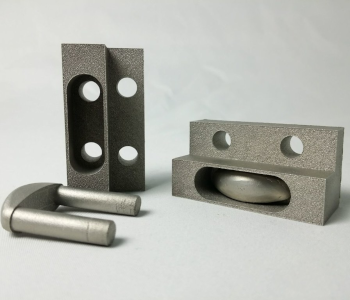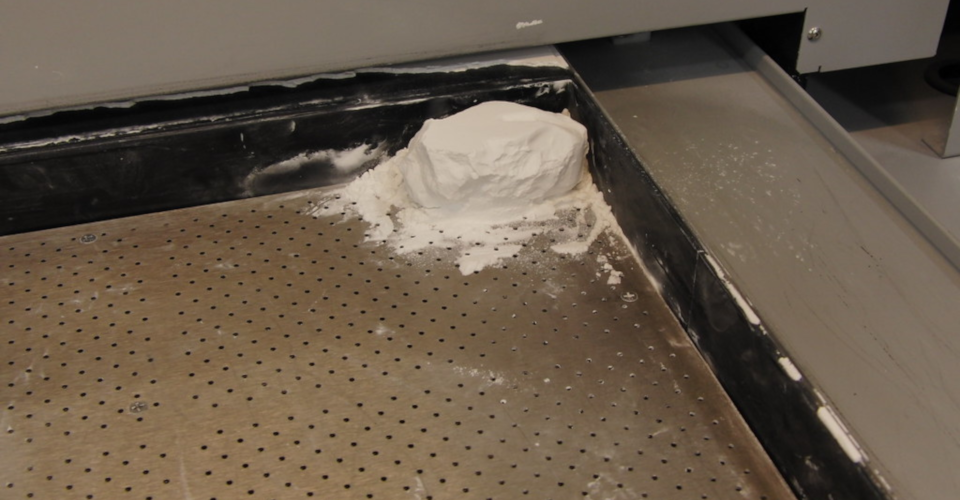What is Powder-Based 3D Printing?
More and more, 3D printers have started to enter the realm of mainstream consciousness. Aside from being incredibly versatile, the technology has become accessible enough even for recreational use. When people think of 3D printers, they often conjure the image of plastic filaments being melted and extruded.
However, filament-based printing is not the only 3D printing technology. Powder-based 3D printing predates plastic filaments by a few decades and continues to be a relevant technique for many professionals and industries. What is powder-based printing and how exactly does it work? What are the different types of powder-based 3D printing?
What is powder-based 3D printing?
Powder-based 3D printing is an additive manufacturing method that uses raw material in powder form. This is in contrast to the filament materials used in other, more common 3D printing techniques. The powder material, in this case, can be either metal or plastic.
The basic principle of powder-based 3D printing is to promote the “binding” of the individual powder particles via the controlled emission of energy. This energy source can be either a laser, a narrow beam of UV light, or an electron beam. The specific method used for 3D printing, hardware parameters and the size of the powder particles all play a role in determining the characteristics of the finished print.
In all other aspects, powder-based 3D printing is similar to other 3D printing techniques. The process also starts with a 3D model of the desired design which then has to be processed by slicer software. This software generates very thin slices of the model which will correspond to layers that the 3D printer will build one by one.
With each successive layer of the powder raw material that the 3D printer binds together, the printer introduces a fresh layer of unprocessed raw powder. This process repeats until the whole model has been generated. In some cases, post-printing treatment will be needed to achieve the material’s optimal physical and chemical properties.
To better understand the technology and working principle of powder-based 3D printing, we’ll take a look at its two major categories: metal-based and plastic-based powder printing. Even for each category, several methods are available.
Metal-based powder printing

In metal-based powder printing, metal powder is fused together through the introduction of a high-energy beam or an agent that promotes binding. Just about all industrially significant metals can be processed via powder-based 3D printing including stainless steel, aluminum, titanium, copper, cobalt, nickel alloy, and chrome.
However, energy requirements and appropriate techniques may vary from one metal to another. For this reason, it’s rare to see a metal-based 3D printer that works well with such an expansive suite of powder metal types.
There are four major technologies used for metal powder 3D printing, and we shall discuss them in sequence from the simplest to the most complex.
Selective laser melting (SLM)
One of the most basic methods of metal 3D printing, SLM uses a concentrated laser beam to melt the raw metal powder. This results in the complete melting of the metal and fusing together of the neighboring powder particles to achieve complex geometries.
The intensity of the laser beam and the speed at which it traverses the layer of metal powder can be adjusted according to the type of metal being processed and to tweak the properties of the finished print. In any case, SLM is a very energy-intensive process because it requires the complete melting of the metal.
The payoff is that SLM produces metal 3D prints with superior mechanical properties. When metal particles melt, they fuse at the molecular level. This process fills in any gaps, creating a denser and stronger product.
Direct metal laser sintering (DMLS)
DMLS is very similar to SLM to the point that the two terms seem to be used interchangeably. They both use a metal powder raw material and a laser energy source to attain fusion. However, there’s a subtle yet essential difference: while the objective of SLM is to completely melt and fuse the metal powder, DMLS strives only to heat the metal particles to the point where their surfaces weld together. This is a process known as sintering and is a more energy-efficient way to fuse metal powder.
The major consequence of choosing sintering over melting is that it creates a product with a lot of porosity. Since the metal does not fully melt and fill in any small gaps inherent to a powdered raw material, the finished product tends to have a lot of small internal cavities. This means that sintered metal products are lighter and also not as strong as those made via SLM.
Electron beam melting (EBM)
In the EBM process, an electron beam delivers the energy necessary to melt the metal powder. This is also a very energy-intensive procedure. The characteristic of an electron beam that makes it unique is that an electron beam can be dispersed to several points on a single layer of the metal powder. This makes EBM a faster 3D printing process compared to SLM and DMLS.
EBM 3D printers are much less common than either SLM or DMLS printers, primarily because of how expensive the technology is. Commercial options for EBM 3D printers are also quite limited. EBM printers also struggle with replicating the level of resolution of other 3D printers because of the size of an electron beam.
Multi-jet Fusion (MJF)
In MJF, a liquid binding agent is injected at selected areas on the bed of metal powder. This is done by an array of ultra-fine nozzles, the number of which directly influences the speed of the process. This binding agent seeps into the interstitial spaces between the powder particles. Its primary function is to promote the absorption of infrared energy.
After the MJF process, the metal print is still considered to be in a “green” state. This will then have to be treated inside a UV chamber to complete the curing and sintering process, allowing the bonds to develop strength.
Out of all the metal powder 3D printers, MJF is the youngest technology and is certainly the rarest. The Metal Jet printer from HP is one of the few popular examples. With its versatility and level of precision, there is still much to be explored with regard to the potential of MJF technology.
Plastic-based powder printing
Compared to other 3D printing methods for plastics, a powder-based method is easily one of the most versatile. There is a wide variety of plastic materials that can be made into powder including silicates or polystyrene, which are generally not available in filament form. Since plastic does not require a lot of energy to melt, the 3D printing technology for plastic powder does not need as much diversity.
Selective Laser Sintering (SLS)

Like the DMLS method for metals, the SLS technique uses a narrow CO2 laser as the energy delivery mechanism to melt the plastic. By varying the intensity and speed of travel of the laser, a single SLS machine can be used across a variety of different plastic materials.
In SLS printing, the CO2 laser hits the layer of powder at pre-determined points according to the model generated by the slicer software. Once a layer has been completed, a roller passes through the top of the vat to introduce a fresh batch of raw plastic powder.
Compared to other 3D printing techniques, SLS has the unique advantage of providing inherent support to the finished layers. When a layer gets printed, all the residual unprocessed plastic powder remains in the build platform and serve to ‘prop up’ the features of the printed project. This means that models don’t have to be designed with support structures, even if they have overhanging features.
As its name implies, the goal of SLS is only sintering, not complete melting of the plastic. This significantly speeds up the process but introduces a lot of porosity to the finished print. The upside of this characteristic is that the process results in lightweight printed parts. However, they aren’t the most durable. They also tend to come out with a rough finish, making post-processing necessary if you want to achieve a smooth surface.
Another major downside of SLS is that it’s much more expensive compared to 3D printing techniques that use plastic filament or resin. For this reason, SLS printers are typically only found in companies that offer professional 3D printing services.
Pros and cons of powder-based 3D printing
Despite powder-based 3D printing techniques being around for quite some time, they haven’t quite caught on at the same level as 3D printers that use plastic filaments or resin. Right now, even SLS printers for plastic are not available at the consumer level. The technology remains industrially relevant, however, which is indicative of its strengths in additive manufacturing.
PROS:
Isotropic mechanical properties
Compared to an additive manufacturing method that uses a filament raw material, products made through powder-based 3D printing are more isotropic in their properties. This means that its mechanical characteristics are consistent across all directions. If you need to produce a functional part that is meant for regular use, the isotropic properties of a 3D printed part mean that you can better predict how well it performs.
Complex geometries
3D printing is an inherently versatile manufacturing technology that was created to reproduce designs that were too complex for more traditional methods. This is particularly valuable for metals. Although methods like extrusion casting and centrifugal casting have been well-developed and are proven to produce metal parts with superior mechanical properties, they have inherently limited design capabilities.
Economical for small volumes
Another benefit of 3D printing is that it doesn’t rely on an economy of scale. On a per-unit basis, it costs just as much to 3D print a single model as it does to 3D printing thousands of iterations of the same model. This is in contrast to manufacturing methods that rely on the production of a solid cast, which is often a huge investment that can only be justified with a large volume of orders.
CONS:
More expensive than other 3D printing methods
Right now, two 3D printing technologies come in desktop-scale models: Fused Deposition Modeling (FDM) and Stereolithography (SLA). Both these technologies produce plastic 3D prints made from either filament or resin. With the inherent simplicity of the technology behind these methods, they have managed to reach a level of accessibility that even hobbyists can afford to have them in their workshops.
Powder-based 3D printers have not quite reached this point yet. Whether for metal or for powder, powder 3D printers are often only used as a prototyping tool for a professional organization or as part of an industrial-scale manufacturing process. They aren’t particularly difficult to use but are several times more expensive than other 3D printing machines.
Final thoughts
3D printing by melting or sintering a powder raw material is one of the more novel technologies, even in such a niche category. Powder-based printers are incredibly versatile in the types of materials they can handle, spanning a wide range of plastics and metals. Printing from powder is also a lot more predictable in terms of the mechanical properties of the finished product.
While powder-based 3D printers aren’t quite as common yet, there is no doubt that they have significant commercial and industrial value. Who knows? Maybe we’ll start seeing fairly affordable desktop 3D printers that use a powder raw material in a few years.





